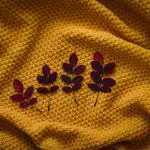Removing silkscreen designs from fabric may seem intimidating, but with the right approach, it can be done effectively. I know what you might be thinking – won't it ruin the fabric or be too time-consuming?
Well, fear not, as I have tried and tested methods that can help you tackle this task with confidence. From evaluating the fabric to gently scrubbing off the design, each step plays an important role in achieving successful results.
So, if you're ready to say goodbye to that old silkscreen and hello to a fresh canvas, let's get started on this transformative journey together.
Table of Contents
Key Takeaways
- Conduct spot testing to determine removal technique.
- Handle silkscreen with care to avoid damage.
- Thoroughly rinse fabric post-removal for residue removal.
- Inspect fabric for successful removal after air drying.
Assess the Silkscreened Fabric
Evaluating the silkscreened fabric is important before attempting to remove the design. Examining fabric quality is essential to determine the best approach for removal. Start by looking at the fabric for any signs of damage or wear that might impact the removal process. Look for areas where the design has faded or cracked, as these sections may need special attention.
Identifying fabric composition is another key step in evaluating the silkscreened fabric. Different fabrics react differently to removal techniques, so knowing what type of material you're working with is crucial. Check the fabric label for information on the composition, as this will guide you in selecting the appropriate tools and materials for the removal process.
Gather Necessary Tools and Materials
To successfully remove silkscreen designs, gather the necessary tools and materials for the task. Tool organization is key to efficiency. Start by laying out all the items you'll need in a clear workspace. Essential tools include a soft-bristled brush, a plastic scraper, rubbing alcohol, and a clean cloth. Make sure these are easily accessible to streamline the process.
Safety precautions are vital when working with chemicals and tools. Wear protective gloves to shield your hands from any harsh substances. Additionally, work in a well-ventilated area to avoid inhaling fumes from the cleaning agents. Safety glasses can protect your eyes from splashes or debris during the removal process.
Having all your tools organized and following proper safety measures won't only make the silkscreen removal process smoother but also guarantee your well-being. By setting up your workspace thoughtfully and taking necessary precautions, you're ready to move on to the next step of testing the removal method on a small area.
Test the Removal Method on a Small Area
After setting up your workspace thoughtfully and ensuring your safety measures are in place, it's time to move on to testing the removal method on a small area. Spot testing is vital before diving into the full process to gauge removal efficiency and assess fabric sensitivity. This step helps in identifying any potential risks or adverse reactions the fabric may have to the chosen removal technique.
| Spot Testing | Observations |
|---|---|
| Area 1 | No visible damage after removal method |
| Area 2 | Fabric slightly discolored, need to adjust technique |
| Area 3 | Removal efficient, no fabric sensitivity issues |
Apply the Chosen Removal Technique
I'll begin by implementing the chosen removal technique on the silkscreen. To prevent restaining, it's important to handle the silkscreen with care and use proper storage methods. Avoiding fabric damage is essential, so I'll be gentle while working on the removal process.
Before proceeding further, I make sure that the removal technique chosen aligns with the type of silkscreen and ink used. This step is important to avoid any potential damage to the fabric during the removal process. By taking these precautions, I aim to maintain the integrity of the fabric and ensure a successful silkscreen removal.
Proper storage of the silkscreen post-removal is equally important. Storing it in a clean, dry place away from direct sunlight and humidity can help prevent any future staining or damage. By following these guidelines and being mindful of gentle handling techniques, I'm confident in successfully removing the silkscreen without causing harm to the fabric.
Allow the Solution to Penetrate the Silkscreen
I find that when removing silkscreen, allowing the solution to penetrate the material is essential. The right penetration time can make a significant difference in the effectiveness of the removal process.
Once the solution has had time to work its magic, remember to rinse off any residue thoroughly for best results.
Penetration Time for Silkscreen
To guarantee effective removal of silkscreen, it's important to allow the solution to thoroughly penetrate the silkscreen before proceeding with the removal process.
- Time Required: Adequate time must be given for the solution to seep into the silkscreen layers effectively.
- Penetration Depth: Make sure the solution penetrates through the entire thickness of the silkscreen for best results.
- Removal Success: The deeper the penetration, the higher the chances of successful removal without residue.
- Even Application: Apply the solution uniformly across the silkscreen to ensure consistent penetration and removal outcomes.
Effective Removal Techniques
For efficient removal of silkscreen, ensuring proper penetration of the solution is essential to achieve best results. Fabric preparation is critical before applying any removal solution to make sure the silkscreen is ready to release the ink effectively. Once the solution is applied, allowing it sufficient time to penetrate the silkscreen will aid in ink removal. Stain prevention techniques can help minimize any potential damage to the fabric during the removal process. Additionally, color restoration methods can be utilized post-removal to bring back vibrancy to the fabric. Employing these techniques in a systematic manner can lead to successful silkscreen removal without compromising the integrity of the fabric.
| Effective Removal Techniques | |
|---|---|
| Fabric preparation | Ink removal |
| Stain prevention | Color restoration |
Rinse off Residue Thoroughly
After confirming that the removal solution has had sufficient time to penetrate the silkscreen, the next step is to thoroughly rinse off any residue to facilitate effective ink removal.
Here are four essential steps to follow after rinsing off the residue:
- Thorough drying: Make sure the silkscreen is completely dry before storing to prevent mold or mildew growth.
- Proper storage: Keep the silkscreen in a cool, dry place away from direct sunlight to maintain its quality.
- Preventing future staining: Regularly clean the silkscreen to prevent ink buildup and staining.
- Maintenance tips: Use gentle cleaning solutions and avoid harsh chemicals to prolong the life of your silkscreen.
Gently Scrub or Peel Off the Design
When it comes to removing silkscreen designs, gently scrubbing or peeling off the design is essential.
Scrubbing off residue, peeling with care, and ensuring that all excess ink is removed are key points to bear in mind when tackling this task.
Let's explore these techniques further to achieve a clean and successful removal process.
Scrubbing off Residue
To effectively remove silkscreen residue, gently scrubbing or peeling off the design is a practical method that yields satisfactory results. When approaching this task, it's crucial to be cautious to prevent any damage to the fabric. Here are some tips for scrubbing off residue effectively:
- Use a soft-bristled brush: This helps to loosen the residue without being too harsh on the fabric.
- Work in gentle circular motions: Gradually scrubbing the residue guarantees even removal without causing excessive wear.
- Check the fabric: Regularly inspect the fabric to make sure the residue is coming off without damaging the underlying material.
- Patience is key: Take your time to avoid rushing the process and potentially causing fabric harm.
Peeling With Care
I find that gently peeling off the silkscreen design can be a critical yet effective method for removing residue without causing damage to the fabric. Careful peeling methods are vital in this process to prevent fabric damage.
When peeling, it's important to proceed slowly and cautiously, making sure that the fabric remains intact. By taking your time and gently lifting the silkscreen design, you can avoid tearing or stretching the material.
Additionally, these silkscreen removal precautions help in avoiding color bleeding, maintaining the fabric's original appearance. Remember, patience is key when peeling off the design to guarantee a clean removal without any unwanted side effects.
Following these steps ensures a successful and damage-free silkscreen removal process.
Removing Excess Ink
Gently scrubbing or peeling off the excess ink is a delicate yet effective method for removing residue from the fabric without causing damage. When dealing with ink stain removal and fabric care, it's important to proceed with caution. Here are some key points to keep in mind:
- Patience is key: Allow the DIY cleaning solutions to work their magic before proceeding with scrubbing or peeling.
- Test a small area first: Make sure the ink removal techniques don't negatively impact the fabric by testing on a hidden spot.
- Use gentle pressure: Avoid harsh scrubbing that could harm the fabric fibers.
- Peel carefully: When peeling off the design, do so slowly and steadily to prevent any tearing or snagging.
Rinse and Clean the Fabric
After the silkscreen has been removed, the next step is to thoroughly rinse and clean the fabric to make sure all residue is gone. I recommend starting by gently rinsing the fabric under cool water to remove any remaining ink, emulsion, or cleaning solution. It's important to be thorough during this step to make sure a clean canvas for your next project. If there are any stubborn stains left on the fabric, you can use a gentle stain remover or a mild detergent to spot-treat them before rinsing again.
Once you've rinsed out all the cleaning agents, carefully inspect the fabric to make sure it's completely clean. Look for any lingering residue or stains that may require additional attention. If everything looks good, proceed with the drying process. Proper drying techniques are critical to prevent any damage to the fabric. You can air dry the fabric or use a low heat setting on your dryer, but always follow the care instructions for the specific type of fabric you're working with.
Air Dry and Inspect the Results
Inspecting the fabric after air drying is important to make sure the silkscreen removal process was successful and the fabric is ready for your next project. After allowing the fabric to air dry completely, it's time to closely examine the results. Here are some key steps to follow:
- Check for Residual Ink: Look carefully for any remaining ink traces. If you notice any spots, consider repeating the cleaning process or spot-treating those areas.
- Inspect for Stains: Examine the fabric for any discoloration or stains that might've been left behind during the silkscreen removal. These could affect the final appearance of your project.
- Feel the Fabric: Run your hand over the fabric to make sure there are no rough or sticky patches. A smooth texture indicates a successful removal process.
- Address Any Issues: If you encounter any problems during the inspection, consider reapplying the cleaning solution or using alternative methods to troubleshoot the issues.
Frequently Asked Questions
Can Silkscreen Designs Be Removed From All Types of Fabric, or Are There Certain Materials That Are More Difficult to Work With?
Certain fabrics are more compatible with silkscreen removal than others. Efficiency varies based on material. Cotton and polyester are commonly easier to work with. Consider fabric type when planning silkscreen removal for best results.
Is There a Risk of Damaging the Fabric While Removing the Silkscreen Design?
Removing a silkscreen design carries potential risks of damaging the fabric if not done carefully. Prioritizing fabric care by using appropriate techniques and products is crucial to minimize any harm during the removal process.
How Long Does the Removal Process Typically Take, and Are There Any Ways to Speed up the Process?
I've found that the removal time of silkscreen designs varies based on the method used. To speed up the process, consider techniques like using solvents or heat. Experiment with different approaches to find what works best for you.
Are There Any Specific Safety Precautions That Should Be Taken When Using the Removal Method?
When using the removal method, always wear protective gear like gloves and goggles. Check the compatibility of the fabric with the chosen method. Safety first! Protect yourself and your surroundings during the process.
Can the Same Removal Technique Be Used for Both Colored and White Silkscreen Designs?
When removing silkscreen, consider the design color. Techniques may vary for colored versus white prints. Fabric compatibility influences the removal process. Understanding these factors guarantees successful removal while preserving the fabric's integrity.
- Why Is Red Velvet Not Red? - April 25, 2024
- How Do You Describe Velvet Fabric? - April 25, 2024
- How Strong Is Velvet? - April 25, 2024







